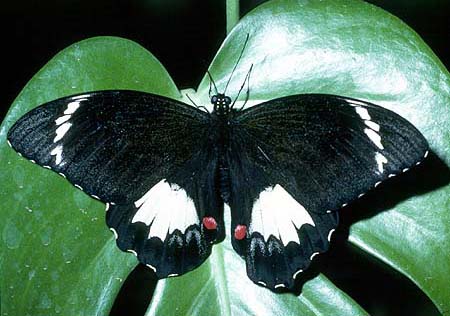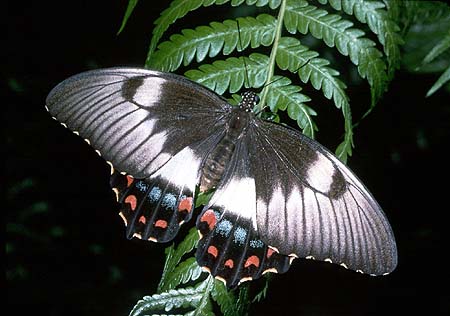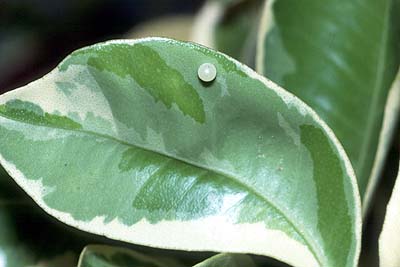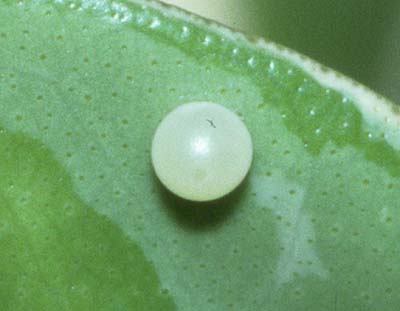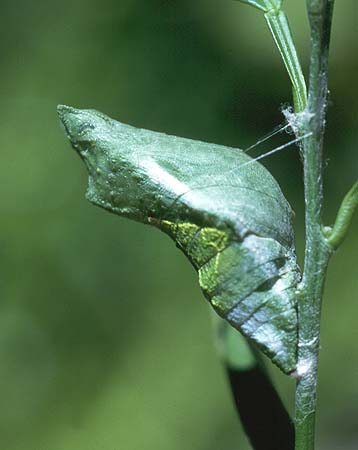-
Larval Food Host
-
Native and introduced Rutaceae. Native hosts include
Citrus (Eremocitrus) glauca (desert lime),
**Eriostemon spp (wax flower),
**Geijera spp including G. parviflora (wilga),
**Philotheca spp (wax flower) incl.
**P. myoporoides (native daphne),
**Phebalium spp, **Zieria spp.
Introduced and preferred hosts include cultivated
*Citrus spp,
*Citrus (Fortunella) spp (kumquat),
*Citrus (Poncirus) trifoliata (wild orange),
*Choisya ternata (Mexican orange-blossom).
The butterfly prefers the tropical and subtropical plant species
of the above plant groups, and in South Australia it has not been
noted to utilise any of the locally occurring temperate species,
including Citrus (Eremocitrus) glauca and
Geijera parviflora. Larvae in captivity can sometimes be
transferred to other swallowtail hostplants like *Apium graveolens (celery),
*Daucus carota (carrot), *Petroselinum crispum (parsley) (Apiaceae),
Owenia sp (emu apple) (Meliaceae), *Capparis nobilis (caper bush) (Capparaceae),
and *Cinnamomum camphora (camphor laurel) (Lauraceae).
The females will not normally lay eggs on these latter plants. The larvae prefer to
eat the young leaves of the hostplant, but larger larvae will eat the older leaves.
-
Eggs
-
Eggs hatch in a week.
-
Larvae
-
The first four instars are the bird-dropping stage. The fifth and final instar is
a green camouflage stage.
All larvae stages feed exposed on the hostplant. When disturbed, the larvae can
evert a reddish orange coloured, fleshy bifid osmeterium
from behind the head that emits a distinct citrus-like pungent odoriferous secretion,
smelling like rotting oranges on the ground beneath an orange tree. This secretion
acts as a deterrent to both vertebrate (birds, lizards and mice) and invertebrate
(ants, spiders and wasps) predators. It is more effective if the chemical can be
deposited on the predator, hence the larvae will attempt to throw their heads (and osmeterium)
either backwards or sideways if a predator attacks from the rear or side.
The secretion is usually composed of a butyric acid compound having irritant properties.
The osmeterium is present in all stages of the larvae, and is found in all the Papilionidae
group of butterflies. In other species the osmeterium can have a different colour such as
green, blue or black.
-
Pupae
-
Pupal stage about 17 days (2-3 weeks).
-
Flight Period in South Australia
-
The butterfly is seen all year round in the humid tropics and subtropics of eastern Australia.
During seasons with abnormal humidity it will move south during summer and autumn, occasionally
reaching South Australia and Victoria. Most of the South Australian records are from the big
invasion of subtropical butterflies that occurred during the summer of
1973-1974.
Interestingly, there were no recordings for the butterfly in SA, during the recent drought
breaking big rains of the 2010-2011 flight season.
-
Distribution
-
Normally a humid tropical and subtropical eastern states butterfly with vagrant tendencies.
Within South Australia the butterfly has been sporadically documented from the southeastern
portion of the state. A small breeding colony was once semi-established at Whyalla but due to
the destructive behaviour of its large larvae on garden Citrus this colony was
short lived. Another breeding colony was reported from Waikerie in the Riverland during the
mid 1970's but it is not known if it still exists. Breeding records from the eastern states
suggest this butterfly would be unable to establish permanently south of about the Waikerie
latitude.
Interested public now have access to live eggs and pupae reared in the heated butterfly
houses of the eastern states, and so it is likely additional random recordings will
continue to occur in future years.
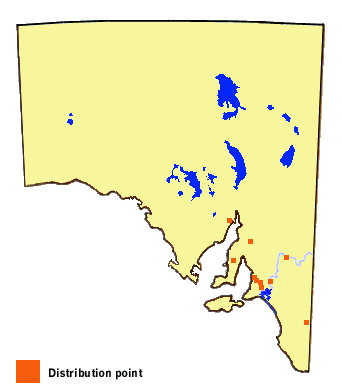
-
Habitat
-
It prefers moist woodland and forest areas.
Potential native and introduced hostplants occur throughout the state, but the butterfly
and its early stages require warm humid and sheltered conditions to survive.
-
Conservation Status in South Australia
-
A vagrant.
-
Threats
-
It is considered a minor pest in the Citrus
orchards occurring in the eastern states and is sometimes sprayed. However, it is
unlikely to survive long in any commercial Citrus orchard due to the persistent
spray activity that occurs in these orchards. Its larvae are large and are capable
of damaging the younger foliage of its hostplant, although usually the larvae numbers are
kept low by natural predators.
-
Conservation Strategy
-
None required.
If you are lucky enough to have the butterfly established in your area then nurture it, as it is a large
spectacular butterfly.
